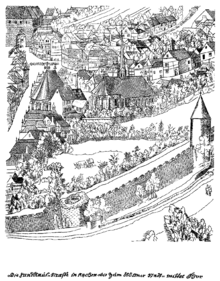Cologne Central Gate

The Cologne Middle Gate was one of the main gates in the inner city wall of Aachen , which is also called the inner ring , first wall or Barbarossa wall . This was built at the instigation of Emperor Friedrich I between 1171 and 1175 and ran roughly where the inner ring of the city of Aachen still runs today. The Kölnmittelor gate is no longer preserved.
history
Like many gates of the inner city wall, the building, initially called "Kölntor", was given the addition "medium" later to avoid confusion with the new Kölntor, completed around 1320 in the outer city wall .
It is said that the Cologne Central Gate was torn down on the outer city wall immediately after the Sandkaultor was built.
Construction
The Cologne Middle Gate was the largest gate of the inner wall and was provided with barbican .
location
The Kölnmittelor was located in the north-east of Aachen in the so-called Barbarossa Wall between the Besterdertor and the Neutor , more precisely where Großkölnstraße and Mefferdatisstraße meet today. At that time the road to Xanten met the road to Cologne at the Kölnmittelor gate .
The name of the gate results from the location, after which travelers from Cologne entered the city through the Kölnmittelor.
Öcher Bend
In Aachen, Öcher Bend is a fair. As early as 1413, the meadow behind the Kölnmittelor gate, also known as “Cöllerporz”, was mentioned as “Bent”. The bend took place there for sixty years. When a new spa promenade was laid out at this point in the 17th century, the “stalls”, “sensations and attractions” moved to the Seilgraben, Bergdriesch and Pontdriesch.
Others
The legend of the defensive blacksmith
On the night of March 16-17, 1278, the so-called Gertrudis Night , Count Wilhelm von Jülich is said to have penetrated the Free Imperial City of Aachen with 469 armed riders in his wake in order to collect taxes due for King Rudolf I of Habsburg and the Subjugate Aacheners. He penetrated the city through the Cologne Middle Gate, which was opened by traitors, and met strong resistance from the citizens of Aachen. When the intruders reached the market, resistance formed, which moved them to flee via Jakobstrasse to the Jakobstor . On the way there, roughly at the level of the former White Women's Monastery in Aachen , they were killed. The legend reports that a blacksmith had already expected Wilhelm and "wordlessly killed him with his heavy iron hammer".
Today the monument created in 1909 by the Aachen sculptor Carl Burger in Jakobstrasse, a few meters in front of the chapel of the Kind-Jesu-Kloster of the Sisters of the Poor Child Jesus , the former White Women´s monastery , reminds of this legend.
environment
In the 13th century, the Martinshospital ( hospitale pauperum extra muros ), which is said to have served primarily as a hostel for pilgrims , was in front of the Kölnmittelor gate . This was relocated to Radermarkt (today Münsterplatz ) in 1336 and is said to have taken over the seal and property of the hospital at Kölnmittelor.
In the years before 1652, Johannes Lodderbein, blacksmith, owned a forge at Kölnmittelor.
See also
Individual evidence
- ↑ Heinrich Schnock: Ais Alikens dead time. Announcements of the association "Aachens Vorzeit", published on behalf of the scientific committee.
- ↑ Description of the Öcher Bend at www.eifel.de
- ↑ Michael Matheus: Functional and structural change in late medieval hospitals in a European comparison
- ^ Families from Eys in the Limburg-Aachen area
literature
- Peter Hermann Loosen: From old Aachen. Historical sketches or Aachen history in stories. 3rd expanded edition. Aquensia-Klette-Verlag, Aachen 1978, pp. 43-46.
- Michael Matheus (Ed.): Functional and structural change in late medieval hospitals in a European comparison (= historical regional studies 56). Franz Steiner Verlag GmbH, Stuttgart 2005, ISBN 3-515-08233-6 ( online version) .
Web links
- Maps and pictures of Aachen from AD 900 to 1599
- Picture gallery of the gates and towers of the Aachen city wall
- Videantur acta! or 100 years memorial "Wehrhafter Schmied" Aachener Geschichtsverein eV
Coordinates: 50 ° 46 ′ 39.6 ″ N , 6 ° 5 ′ 15.5 ″ E
